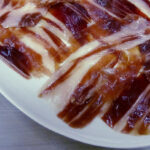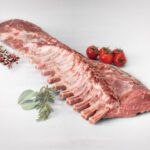The dehesa is a unique ecosystem in the Iberian Peninsula, where holm oak and cork oak forests are combined with extensive meadows. This privileged environment is not only the ideal habitat for rearing Iberian pigs, but also plays a key role in the quality of the final product. Thanks to its size and biodiversity, the dehesa allows the animals to develop in freedom, following a natural cycle that has been the basis of extensive livestock farming for centuries.
Historically, the dehesas have been used for agriculture and livestock farming, providing essential resources for rural communities. Over time, they have become the perfect setting for the production of Iberian ham, especially in the acorn-fed category, where the pig’s diet is based on the fruits of holm oaks and cork oaks during the montanera. This process gives the meat a unique fat infiltration, responsible for its juicy texture and unmistakable flavour.
In addition to its impact on product quality, pasture farming is fundamental for sustainability. These ecosystems not only contribute to the conservation of the environment, but also protect biodiversity and promote a balance between livestock farming and nature. Pasture rotation, tree regeneration and control of animal populations ensure the continuity of this system, respecting tradition without sacrificing excellence.
The model of extensive farming on the dehesa also boosts the rural economy, generating employment and ensuring the continuity of a trade linked to the land. From the farmers to the master ham makers, each link in the production chain contributes to keeping alive a tradition that has made Iberian ham a symbol of Spanish gastronomy.
In short, the dehesa is not only the home of the Iberian pig, but also the cradle of an exceptional product whose quality depends directly on this natural environment. Caring for the dehesas and preserving their balance is to guarantee the future of one of Spain’s greatest gastronomic treasures.





